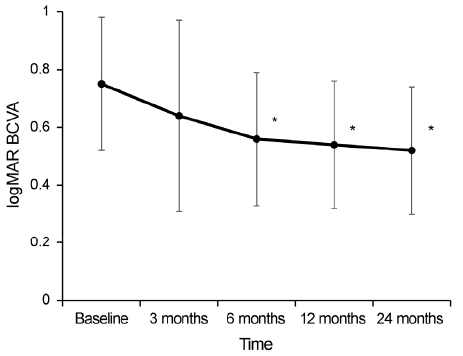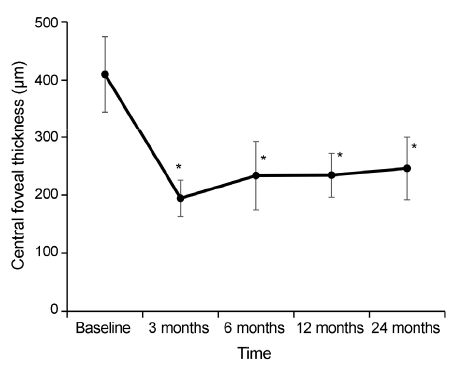J Korean Ophthalmol Soc.
2017 Jun;58(6):646-652. 10.3341/jkos.2017.58.6.646.
Long-term Results of Reduced-fluence Photodynamic Therapy Combined with Intravitreal Anti-Vascular Endothelial Growth Factor for Polypoidal Choroidal Vasculopathy
- Affiliations
-
- 1Department of Ophthalmology, Korea University College of Medicine, Seoul, Korea. ksw64723@korea.ac.kr
- KMID: 2382672
- DOI: http://doi.org/10.3341/jkos.2017.58.6.646
Abstract
- PURPOSE
To evaluate the long-term effects of reduced-fluence photodynamic therapy (RF-PDT) combined with intravitreal anti-vascular endothelial growth factor (anti-VEGF) for polypoidal choroidal vasculopathy (PCV).
METHODS
Twenty-two eyes of 21 patients with PCV that were followed up for more than 24 months after RF-PDT and anti-VEGF combination therapy were retrospectively reviewed. The patients received intravitreal anti-VEGF (bevacizumab 1.25 mg, ranibizumab 0.5 mg, or aflibercept 2.0 mg) within 7 days of PDT. Patients were retreated with either RF-PDT and anti-VEGF injection, or with only anti-VEGF injection, as indicated. The main outcome measures were best-corrected visual acuity (BCVA) and central foveal thickness (CFT), which were measured before and after combination therapy.
RESULTS
During follow-up, the mean logMAR BCVA significantly improved from 0.75 at baseline to 0.54 at 12 months and 0.52 at 24 months (p=0.009 and p=0.032, respectively). The mean CFT significantly decreased from 409.8 µm at baseline to 234.1 µm at 12 months and 245.9 µm at 24 months (p<0.001 and p=0.001, respectively). In 20 eyes (90.9%), the BCVA remained stable or improved.
CONCLUSIONS
The efficacy of this combination therapy for 24 months resulted in stabilized vision and anatomical improvement. RF-PDT combined with intravitreal anti-VEGF injection could be an effective treatment modality for patients with PCV.
Keyword
MeSH Terms
Figure
Reference
-
1. Yannuzzi LA, Sorenson J, Spaide RF, Lipson B. Idiopathic polypoidal choroidal vasculopathy (IPCV). Retina. 1990; 10:1–8.2. Ciardella AP, Donsoff IM, Huang SJ, et al. Polypoidal choroidal vasculopathy. Surv Ophthalmol. 2004; 49:25–37.3. Uyama M, Matsubara T, Fukushima I, et al. Idiopathic polypoidal choroidal vasculopathy in Japanese patients. Arch Ophthalmol. 1999; 117:1035–1042.4. Uyama M, Wada M, Nagai Y, et al. Polypoidal choroidal vasculopathy: natural history. Am J Ophthalmol. 2002; 133:639–648.5. Lee WK, Kwon SI. Polypoidal choroidal vasculopathy. J Korean Ophthalmol Soc. 2000; 41:2573–2584.6. Gomi F, Sawa M, Sakaguchi H, et al. Efficacy of intravitreal bevacizumab for polypoidal choroidal vasculopathy. Br J Ophthalmol. 2008; 92:70–73.7. Koh A, Lee WK, Chen LJ, et al. EVEREST Study: efficacy and safety of verteporfin photodynamic therapy in combination with ranibizumab or alone versus ranibizumab monotherapy in patients with symptomatic macular polypoidal choroidal vasculopathy. Retina. 2012; 32:1453–1464.8. Ojima Y, Tsujikawa A, Otani A, et al. Recurrent bleeding after photodynamic therapy in polypoidal choroidal vasculopathy. Am J Ophthalmol. 2006; 141:958–960.9. Hirami Y, Tsujikawa A, Otani A, et al. Hemorrhagic complications after photodynamic therapy for polypoidal choroidal vasculopathy. Retina. 2007; 27:335–341.10. Tsujikawa A, Hirami Y, Nakanishi H, et al. Retinal pigment epithelial tear in polypoidal choroidal vasculopathy. Retina. 2007; 27:832–838.11. Lai TY, Chan WM, Liu DT, et al. Intravitreal bevacizumab (Avastin) with or without photodynamic therapy for the treatment of polypoidal choroidal vasculopathy. Br J Ophthalmol. 2008; 92:661–666.12. Yamashita A, Shiraga F, Shiragami C, et al. Two-year results of reduced-fluence photodynamic therapy for polypoidal choroidal vasculopathy. Am J Ophthalmol. 2013; 155:96–102.e1.13. Ricci F, Calabrese A, Regine F, et al. Combined reduced fluence photodynamic therapy and intravitreal ranibizumab for polypoidal choroidal vasculopathy. Retina. 2012; 32:1280–1288.14. Sagong M, Lim S, Chang W. Reduced-fluence photodynamic therapy combined with intravitreal bevacizumab for polypoidalchoroidal vasculopathy. Am J Ophthalmol. 2012; 153:873–882.e2.15. Lalwani GA, Rosenfeld PJ, Fung AE, et al. A variable-dosing regimen with intravitreal ranibizumab for neovascular age-related macular degeneration: year 2 of the PrONTO Study. Am J Ophthalmol. 2009; 148:43–58.e1.16. Imamura Y, Engelbert M, Iida T, et al. Polypoidal choroidal vasculopathy: a review. Surv Ophthalmol. 2010; 55:501–515.17. Wong CW, Yanagi Y, Lee WK, et al. Age-related macular degeneration and polypoidal choroidal vasculopathy in Asians. Prog Retin Eye Res. 2016; 53:107–139.18. Wakabayashi T, Gomi F, Sawa M, et al. Marked vascular changes of polypoidal choroidal vasculopathy after photodynamic therapy. Br J Ophthalmol. 2008; 92:936–940.19. Lee PY, Kim KS, Lee WK. Photodynamic therapy with verteporfin in polypoidal choroidal vasculopathy. J Korean Ophthalmol Soc. 2004; 45:216–227.20. Silva RM, Figueira J, Cachulo ML, et al. Polypoidal choroidal vasculopathy and photodynamic therapy with verteporfin. Graefes Arch Clin Exp Ophthalmol. 2005; 243:973–979.21. Schmidt-Erfurth U, Laqua H, Schlötzer-Schrehard U, et al. Histopathological changes following photodynamic therapy in human eyes. Arch Ophthalmol. 2002; 120:835–844.22. Tzekov R, Lin T, Zhang KM, et al. Ocular changes after photo dynamic therapy. Invest Ophthalmol Vis Sci. 2006; 47:377–385.23. Tatar O, Adam A, Shinoda K, et al. Expression of VEGF and PEDF in choroidal neovascular membranes following verteporfin photodynamic therapy. Am J Ophthalmol. 2006; 142:95–104.24. Tatar O, Shinoda K, Adam A, et al. Effect of verteporfin photodynamic therapy on endostatin and angiogenesis in human choroidal neovascular membranes. Br J Ophthalmol. 2007; 91:166–173.25. Gomi F, Sawa M, Wakabayashi T, et al. Efficacy of intravitreal bevacizumab combined with photodynamic therapy for polypoidal choroidal vasculopathy. Am J Ophthalmol. 2010; 150:48–54.e1.26. Yoshida Y, Kohno T, Yamamoto M, et al. Two-year results of reduced-fluence photodynamic therapy combined with intravitreal ranibizumab for typical age-related macular degeneration and polypoidal choroidal vasculopathy. Jpn J Ophthalmol. 2013; 57:283–293.
- Full Text Links
- Actions
-
Cited
- CITED
-
- Close
- Share
- Similar articles
-
- Anti-vascular Endothelial Growth Factor Monotherapy and Pneumatic Displacement for Submacular Hemorrhage in Polypoidal Choroidal Vasculopathy
- Two-year Outcome of Intravitreal Anti-vascular Endothelial Growth Factor Therapy for Polypoidal Choroidal Vasculopathy
- Peripapillary Choroidal Thickness Change of Polypoidal Choroidal Vasculopathy after Anti-vascular Endothelial Growth Factor
- Photodynamic Therapy with Verteporfin in Polypoidal Choroidal Vasculopathy
- Treatment of Exudative Age-Related Macular Degeneration



